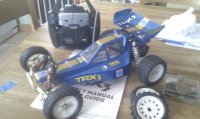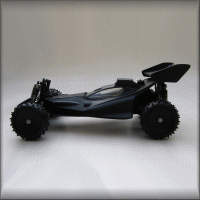|
|
|
TOPIC:
Re: Chargers? 11 years 7 months ago #12702
|
I know you're all waiting for a "comedy" response from me on the subject, so here goes....
PERSONALLY I'm a fan of NiCd batteries & "run-back" clockwork fast chargers. This has come from nothing but bad experience from unreliable & fragile Nimh batteries & the number of packs that have been rendered useless by "peak-detect" electronic chargers. My own personal experience of Nimh packs is that if you get them warm (Through charging or use) they refuse to be charged anymore. If you don't use them regularly, they won't charge anymore. I've also noticed that the instantaneous current they'll supply is far less than good quality NiCd packs. I'll tell you now, using Nimh with a clockwork charger is likely to render them doorstops. Moving on... I like clockwork chargers because you're not limited to the amount you can charge a battery, whereas peak-detect chargers refuse to go any further than when they THINK the batteries are charged. For instance, if you have a battery that's got lazy because its been charged & not used, or has been sitting about, a peak detect will turn itself off as soon as the battery voltage starts to drop during charging (This is what happens when a good battery reaches it's fully charged state, normally due to the internal resistance of the cells increasing due to heat build-up, I think). Lazy batteries get warm before they're charged & peak detect chargers pick up on that (& the corresponding voltage drop) & say "It's done, I'm turning off now & there's nothing you can do to stop me". Lazy NiCds need to be taken beyond that point, to recover them to full capacity, & a run back charger is the only way to do it. Nimh just get upset at the fact they're being made warm, & just die from it. A couple of recent observations: After ditching NiCd power tool batteries in favour of Nimh, RS have re-introduced NiCds as "Higher power, more reliable, longer life" upgrades (& are charging much more for them!). - yep, my NiCd powered Bosch is on its original batteries from 2000, my Nimh powered, identical model bosch is now on its 3rd set since 2003. Charger is peak & temperature detect, incidentally. The people who took over from Ugobe are now offering a special "recovery charger" to pump life back into Pleo's Nimh pack "When it has been stored for a month or more & refuses to be charged on the standard (peak-detect) charger". They also supply Lithium packs with the later models, replacing the Nimh - yep, my Pleo's battery died a month after I got him, plan is to rebuild the pack with NiCd & bring him back to life when I get a spare hour or 3. Trickle charging after fast charging - I'd also heard that, but I think it's more to do with keeping the battery in a "just charged" state when you're using them in a racing environment. If you have a volt meter handy, plug it into the battery whilst its charging. What you should see is the voltage gradually increasing to close to what the charger supply voltage is, usually somewhere between 11 & 12 volts for a good condition, good quality NiCd pack. When it's fully charged, this voltage will drop slightly, which is what peak-detect chargers use as their signal to stop charging). If at this point you hook the battery up to a slow/trickle charger, the battery will maintain (To some degree) this higher voltage. If you just disconnect the pack from fast charging, it'll usually drop back to around 8-9v over the next 10 minutes or so. Don't leave it on trickle charge for lengthy periods though, it'll affect the "full" capacity of the pack (Or damage it through overcharging). Most run-back fast chargers automatically go into "trickle charge" at the end of the fast charge period. Interesting statement - on Mardave's website they say slow charging DOESN'T do anything good for the battery, & packs should be fast charged only. Being interested in them, I do watch Ebay prices of clockwork chargers. No-one wants them unless they're something that could be classed as vintage or interesting. Normally, whether or not they sell is governed by the postage cost, which will always be more than the final selling price of the charger. If you've got one, don't bother selling it, keep it for that day when you remember how much better NiCds were.... Failing that, they're easily converted into a "Battery discharger" - Cut the connector(s) off the input (12v) lead & replace with a battery connector. Cut the old battery connector off the output lead (7.2v charging) & wire it through an old automotive bulb. The bulb provides an extra current sink (So you don't fry the internal resistors) & is also useful to show when the battery's finally flat (The bulb goes out). The swapping of connectors ISN'T necessary if you're sure the charger HASN'T got a reverse-polarity-protection diode (...which would otherwise prevent reverse-flow from the battery to bulb). DON'T try this with mains-powered chargers, only the type that are supplied by a car battery or cigar socket supply (ie 12V input). Obviously it won't work with electronic chargers either, only ones with a clockwork timer & hefty load resistors, eg Acoms, Tamiya "brick", MFA etc. & finally.... After many years of NiCd use, I've found that lower capacity packs (1200-1400mAh) usually behave better than higher capacity ones (150-1800mAh+). Although they don't last as long, the low capacity ones tend to give more "punch" & are less likely to suffer from "memory effect". Obviously the better quality ones are "better" than the cheapy ones. Tamiya packs are fantastic in my opinion, & are well worth spending that little extra for. In fact, I've got a couple of Tamiya packs here left over from my racing days, back in the 80s, which still work well, & have exceeded the performance given by any Nimh packs I've ever owned!
Custom F2
...
Hilux crossmember drawing
...
F2 axle drawing
...
Quattro radio lid
...
Holiday Buggy motor bracket drawing
...
Quattro resto
...
HitnMiss engine
...
Wild Willy resto
...
Mardave Cobra resto
...
Thunder Dragon resto
...
Grasshopper resto
...
XR311 resto
...
Modded XR311
...
Carbon 25th scratch build
|
|
|
Please Log in to join the conversation.
Last edit: by eddrick. Reason: brain-fade
|
Re: Chargers? 11 years 7 months ago #12703
|
This is going to be a long google translate, but its from a german article i have just been reading. think it fits to what Eddrick wrote and I agree that NiCd seem to be more enduring, I got a Tamiya 6V 4000 (the big bruiser one) and a 6V hardcase for my M38 that still work quite nicely (I got them both with 0V and they probably have been lying in a basement for years)
Wildflyer method - batteries in top condition for maximum performance! please excuse googles bent and funny english. @ mods just delete it if it is to crappy to read. With this article I want to share my experiences and tests with NiMh cells. I have dealt with for over a year my battery wrong and flew with much power is too low, and that's all because I have the "popular opinion" is part of the treatment of NiMh cells. Obviously, at some point someone put the wrong treatment method in the world that has any then simply parroted, and thus also its batteries ruined! I have so for over half a year and done extensive testing with my cells and thereby revealed the secret of the processes in the individual cells in everyday practice. The test results, which I mention here are based on 16-zelliges NiMH battery packs of the cell type: GP330-SCHR with 3300mAh rated capacity. Before my test was the battery yield a fully charged battery only about 2.0 Ah, but my goal was at least 3.0 Ah again, since I had that value in Errinnerung when the cells were brand new. The result after the cells were treated with the Wildflyer method was: You were back as good as new and even better at the voltage situation! The story: The fact was that my battery packs have gotten through the long mishandling a very large memory effect. When a battery pack was fully loaded, always the same 5 cells were extremely hot, while the others were not even lukewarm. Just after discharge and again the same 5 cells had been heated glowing hot while the other only slightly. I dismantled a battery pack and have loaded and unloaded every 16 cells individually. It just had the 5 cells that were constantly too hot just 2000mAh, 2500mAh and the other approx. Now I was very disappointed at the time by far the "most expensive cell" and about the fact that she would not even be held for one season. In search of advice I have with "Hopf" call (specialist gepushte and selected battery pack), described my problem, and then get as a solution following suggested: "The batteries are not all fully equal, so I can not all the capacity discharged . as "treatment" should I use the battery pack for 2 days. 400mAh with continuous charge, then all cells were at the same level, and thus the full capacity removable " ... said than done ... I then loaded with 400mA for 2 days, then unloaded and placed firmly back only removable 2000mAh capacity, so any improvement of my problem! So the "Hopf method" was probably the full time! Then I called at various retailers who have only me but all said that my cells need to be replaced with new ones, as generally known, is the NiMH cells are not particularly durable (such a badword!! ... But more on that later ...). Then I called at Schulze electronics, described my problem, and finally someone had a clue! It was confirmed that NiMh cells can also have a memory effect, and how to get off this again. I should discharge each cell individually with a resistor and a diode "overnight" and then recharge and repeat this procedure every day, until the battery is fit again. ... Said and done ... , After about 8 days and 8 cycles my batteries had come up until then gigantic 2900mAh!. That was already what! But what even the Schulze guys did not know, that's not the battery charge cycles to clean the inside, but the long discharge time with lowest power with surface mount diodes. So the battery can be discharged four days with just diodes, would have brought more than the 8 cycles, but I've then also later found out. Madness, I now had a battery with 2900mAh, record! Then I strictly followed the treatment of "Jackson", the diodes removed, discharge the battery to exactly 1V per cell fly after the charger and at home then at minus 20 degrees stored in the freezer and thawed just before each use and loaded. The fun w
The following user(s) Liked this: Edou
|
|
|
Please Log in to join the conversation.
Last edit: by Edou. Reason: Minimal adaptation
|
Re: Chargers? 11 years 7 months ago #12706
|
I have one like
this
, one very similar but does 4.8v - 9.6v, and two with variable fast charge rate knobs. One I bought new in 1999, the other three were 2nd hand, all work fine so I think they're a pretty sound used buy
|
|
Please Log in to join the conversation. |
Re: Chargers? 11 years 7 months ago #12708
|
@Waterbok - Interesting article. Can you post the images associated with it (i.e. drawings of the setup - worth 1000 words as they say), or link to the original article? I understand a bit of German, so should able to get the gist.
Edit: @JR - Yeah, I am bidding on one similar to that right now - Ripmax Pro Peak 2500. |
|
Please Log in to join the conversation.
Last edit: by Martin Bell.
|
Re: Chargers? 11 years 7 months ago #12711
yup, found the british flag joke quite amusing. hence the google translate. |
|
|
Please Log in to join the conversation. |
Re: Chargers? 11 years 7 months ago #12713
|
Very interesting article. I always thought NiMHs died when you left them uncharged.
Seems that practice has proven this... I discharge my packs before I fully charge (and use) them again. Hopefully that will also help a bit against memory effect. If they ever start losing capacity, I may give this method a try. Btw - I only changed the last bit in your post to make a clearer division between the tested and untested batteries. Read (most of) the German page but the English translation looked quite understandable too.
The following user(s) Liked this: waterbok
|
|
|
Please Log in to join the conversation.
Last edit: by Edou.
|
Re: Chargers? 11 years 7 months ago #12716
|
Er..... I think I get the jest of what's being said there, but my brain left about a 3rd of the way through & jumped out of the window....
I used to play the cell-swapping/matching game years ago, mainly with power tool batteries - when you notice one or more cells getting hotter than the rest during charging, split the pack, note the "rest voltage" of the individual good cells (The cool ones), then match with cells with similar properties (Rest voltage & capacity) & use these to replace the duffers. I found I got more accurate matches if the cells were flat, then "spiked" for 3 seconds each with a 12v lead-acid battery & their voltage re-measured & matched (To get some idea of their ability to transfer large currents). However, although this method worked ok for mundane stuff like power tools, torches & porta-vacs, it wasn't really good enough for toy car race-packs, which I guess have to be closer-matched to deal with the much larger currents involved. Nowadays, it's just much cheaper & easier to keep an eye out on Ebay for people retiring their "Obsolete" Tamiya NiCds (In favour of Nimh or Lipo) & re-train them. Re-training NiCds - What I do is to fully discharge the pack (Using an automotive headlamp bulb), cool it if it's really hot, then fast charge it on the run-back charger until it gets fairly warm (I'll often do this with an ammeter in-line & voltmeter across the battery, to keep an eye on charging voltage & current, so I've got some numbers as comparisons for future charging). THEN, immediately after charging, stick the pack in a toy car & give it a severe thrashing until it stops moving (This provides a far better current drain than any discharger). After the car stops moving, count to 20 & try to drive it again (It'll probably keep having little spurts) It's a good idea to be using a separate Rx pack when doing this..... Keep doing this until waiting doesn't make any difference, then take the pack out & stick the headlamp bulb across it to completely flatten it (There won't even be a glow from the bulb). Again, I usually monitor this with the multimeter to make sure I get the pack as empty as possible. The pack will get hot as it approaches 0v, so try to keep it cool. THEN, when it's cool, fast charge it again, immediately run it completely flat again & so on. you should find that each time you do this, it takes slightly less time to charge, will charge at a slightly higher current, & will finish charging with a slightly higher voltage. You should also notice slight increases in performance each time, ie the car will have more "poke" & the pack will run for longer at higher speed, then go flat all of a sudden, which is what you're aiming for. You should also find that the pack won't be getting so hot either. It usually takes about 3 or 4 of these cycles to get a "dead" pack usable again. Any more & I usually condemn them (Through loss of interest...). The pack must be run flat immediately after charging, it's no good leaving it for an hour or discharging with a discharger, it has to be done NOW & at the highest rate the pack can manage, otherwise you'll just make it worse. You'll never get a rubbish quality pack (ie above 1500mAh usually, Maplin, Heng Long, Foo-King etc) to recover, so don't bother with them. Works best with Tamiya packs & others below 1400mAh. This method usually destroys Nimh packs by the end of the first run (Due to heat?), so it kinda finalises that "shall I buy a new one?" decision too.
Custom F2
...
Hilux crossmember drawing
...
F2 axle drawing
...
Quattro radio lid
...
Holiday Buggy motor bracket drawing
...
Quattro resto
...
HitnMiss engine
...
Wild Willy resto
...
Mardave Cobra resto
...
Thunder Dragon resto
...
Grasshopper resto
...
XR311 resto
...
Modded XR311
...
Carbon 25th scratch build
|
|
|
Please Log in to join the conversation. |
|
|
|
Time to create page: 0.111 seconds





